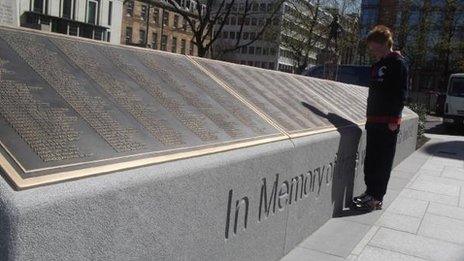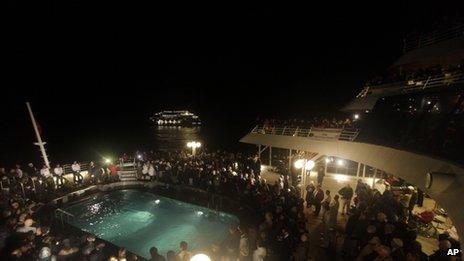Titanic tragedy remembered in special events
- Published
- comments
The 100th anniversary of the sinking of the Titanic is being remembered at a number of a special events, including one in the ship's birthplace Belfast.
A memorial service for the 1,500 people who died was held at the North Atlantic wreck site on cruise ship MS Balmoral, which is retracing the Titanic's route.
A minute's silence was held and wreaths were cast into the sea at the moment the Titanic sank.
And a plaque featuring the names of those who died was unveiled in Belfast.
The ship, which at the time was the largest vessel in the world, was built in the city.
The plaque, in the Titanic Memorial Garden, lists the names of those who died in alphabetical order.
Thousands attended or listened to the Belfast service, which was held at the city hall.
Una Reilly, head of the local Titanic Society, said: "We are all proud of this ship. What happened was a disaster, she was not."
And a memorial service was held in Southampton, from where the ship set sail five days before its sinking.
The anniversary has been marked in a number of services across the UK.
<itemMeta>news/uk-england-surrey-17721040</itemMeta> who died after staying at his post until his equipment failed
<itemMeta>news/uk-wales-north-west-wales-17719472</itemMeta> was unveiled at his home town of Barmouth, Gwynedd, because records show he commanded the only lifeboat to look for survivors, pulling four people from the freezing water
<itemMeta>news/world-europe-guernsey-17694113</itemMeta> in the accident were commemorated with the unveiling of a plaque
And a service described as an act of remembrance <itemMeta>news/uk-england-merseyside-17713196</itemMeta>
Earlier, on the Balmoral, passengers and crew members listened in silence as the names were read out of those who died when the liner sank on its maiden voyage.
Jane Allen's great-uncle, Thomas Pears, was one of those who died.
Explaining the emotions she felt during the service, she told the BBC: "It was just so eerily quiet.
"And then you look down over the side of the ship and you realise that every man and woman who was not fortunate enough to get into a lifeboat had to make that decision of when to jump or to stay with the ship, until the lights went out.
"And when the lights went out it must have been horrendous. We witnessed that tonight."
Melinda Norris, whose relative Charles Lightoller was a surviving crew member, said: "You still get a chill just looking at that water, imagining you have to go into it.
"We've been listening to the names of the 1,500 people who died.

A newly unveiled plaque at the Titanic Memorial Garden in Belfast features the names of those who died on the Titanic
"It's just an unimaginable amount of suffering took place here, so it's surreal to be here."
Richard Hyman's great-grandfather was also on board Titanic and lived to tell the tale.
Mr Hyman said: "You imagine it's pitch black, freezing cold, nothing is anywhere near you other than an iceberg.
"The fear that must have been with all those people who were either stuck on the ship or in a lifeboat, not knowing whether they were going to survive or not.
"And people did freeze to death as well, even though they'd survived the disaster."
Another cruise ship, Azamara Journey, which has travelled from New York, also held a service at the site of the disaster, which occurred 400 miles (640km) off the coast of Newfoundland.

Many of those who participated in a memorial service on board MS Balmoral were related to people who died when the Titanic sank 100 years ago
The sinking is also being remembered in other parts of the globe including New York, which had been the Titanic's intended destination.
About 1,300 passengers, ranging from millionaires to poor emigrants, and about 900 crew were on board the Titanic when it sank on its maiden voyage.
The ship left Southampton on 10 April 1912. It headed to Cherbourg in France and Queenstown - now Cobh - in the Irish Republic before heading for New York.
The ship hit an iceberg at 23:40 (Ship's Time) on 14 April 1912, and sank two-and-a-half hours later.
- Published15 April 2012